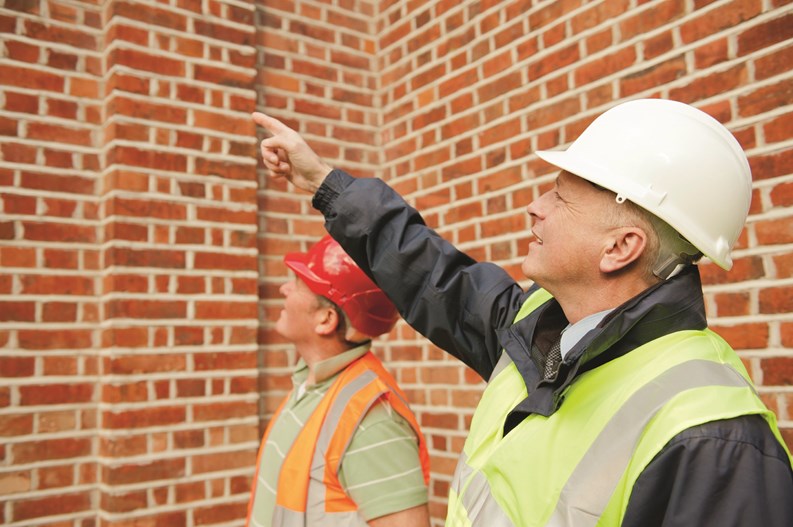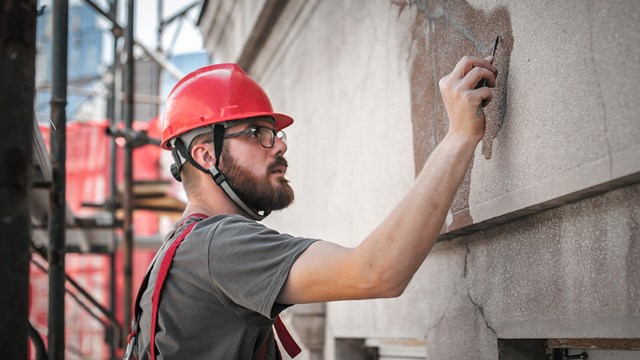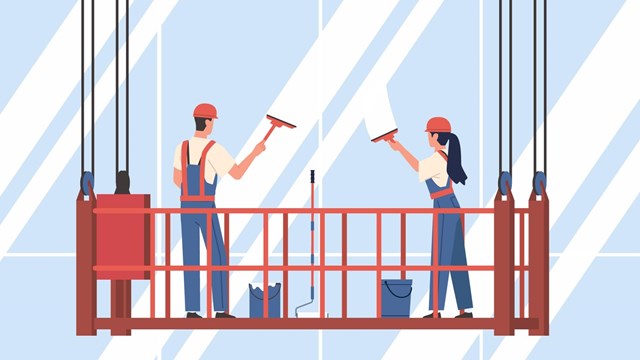Exteriors of buildings—condos and HOAs included—aren’t always just smooth brick walls. There are all sorts of indentations and protrusions, from terraces to stonework to cornices. There are also items that are not part of the building, but are affixed to it, from scaffolds to window air conditioners. And if such items aren't properly secured to the building, this could lead to disaster.
Remember that Chicago is the Windy City (although some historians claim that the name doesn’t refer so much to the gusts coming off Lake Michigan as it does to early politicians who were full of hot air). And if something is loose on the exterior of your building, high winds can turn them into dangerous projectiles, whether you’re in the city itself or the suburbs.
Danger From Above
Consider these incidents:
• In March of this year, during 30 mph winds, bricks fell from a building on West Van Buren Street in a busy area of the Loop, although there were no injuries.
• In April of this year, debris fell from the top of another high-rise building in the Loop, this time on South State Street. Again, no one was injured.
• Also this April, falling scaffolding and debris from the Chicago Stock Exchange building led to lane closures. Local news sources reported that high winds may have been to blame.
• In September 2014, a woman was walking with her boyfriend when a piece of decorative metal came loose from a century-old church, which in turn knocked off a piece of a stone gargoyle jutting from a corner of the church. The heavy stone hit her on the head and killed her.
• When this type of thing happens in the Loop, it makes headlines but it happens elsewhere, too. What kind of material or device, either affixed to the building, installed on the building or part of the building, could become loose and create potentially deadly hazards?
Among the many items are:
• Construction debris left on the roof or elsewhere (plywood, bricks, paint cans, ladders, tools, etc.)
• Protective canopies, scaffolds and other temporary structures used by workers during construction or exterior repairs.
• Loose bricks, stonework or terra-cotta (mainly on older buildings)
• Siding material.
• Signage
• Deck furniture
• Window air conditioning units
Some of the above-mentioned situations, of course, are more common that others when it comes to Chicagoland-area condos.
“Most of the high-rises in the city have central air conditioning,” says Brian Lozell, director of condominium management at Seneca Real Estate Group in Chicago, “so falling window A/C units aren’t as much of a factor. “When you hear of a falling window air-conditioning unit, it’s usually from the second floor of a house.”
Also, as far as deck furniture is considered, he said, most of the furniture is fairly heavy (although there are also ordinances governing flower pots and plants on terraces and decks), and if it were to fall, the unit owner would be responsible.
Lozell, who is also president-elect of the Chicago chapter of the Institute of Real Estate Management, says, “Most of the time, when I’ve found myself in Housing Court [because of falling material], it’s because something like a piece of terra cotta or a brick falls”—in other words, something that’s part of the building exterior, and therefore the responsibility of the association as a whole, rather than just one person.
It’s in the Code
“In Chicago, we have a lot of high winds—and accidents involving construction debris and other falling objects tend to occur when there are high winds,” says Mimi Simon, director of public affairs for the Chicago Department of Buildings.
To illustrate, Simon provided some portions of the Chicago Building Code pertaining to construction and maintenance of exterior walls. For example, concrete masonry and mortar used in the construction of any single-wythe exterior wall of any residential building need to have an integral water repellent included in the manufacturing process, and all joist-mixed mortar must have a compatible water repellent added to the mixture. Also, wall anchors and metal veneers need to be made of non-corrosive materials, or must be protected by corrosive-resistant treatment.
In addition, says Simon, the owner of any building over 80 feet tall is subject to the city’s Exterior Wall Program, which was enacted in 1996 and most recently revised in 2009. Owners must schedule exterior inspections and submit reports to the Buildings Department. In addition, the owner must perform remedial work and repairs set for the ongoing inspection and repair report.
If the last inspection report classifies their building as “safe” or “safe with repair and maintenance,” boards and owners can choose to file “short forms” every two years, rather than the full critical examination reports at mandated frequencies. But if according to the program, if there is any doubt about a building’s structural integrity, the Buildings Department may request the owner to have the building examined by a licensed architect or a registered structural engineer.
Part of the program, by the way, deals with what the Buildings Department calls appurtenances—“exterior wall balconies, fire escapes, chimneys, hanging (window) air conditioners, marquees, at-grade canopies, flagpoles, and window-washing and exterior maintenance systems.” There is also material in the Exterior Wall Program’s ordinance about material affixed to walls with metal fasteners, which must be corrosion-resistant.
Fines, Orders of Compliance and More
According to the ordinance, if the inspecting professional finds conditions that could compromise the integrity of the wall, he or she must inform the owner in writing about the need for further examination. Paul Satti, technical director for the Construction Safety Council in Hillside, adds that in the case of scaffolds, “Part of the scaffold ordinance says that if the velocity of the wind exceeds the velocity for which the scaffold was designed, the scaffold must be taken down.”
No matter what the cause, Simon adds, “The city takes incidents of falling material and debris from buildings very seriously. Emergency duty officers are sent to the building immediately upon notification, and the area is cordoned off as soon as possible. Upon evaluation, citations to the building owner are issued for violation of the code, and sanctions may include fines, orders of compliance, and in extreme situations, the closure of the building pending compliance.”
As Simon mentioned, fines are not the worst thing that can happen to a board when violations are found. Gerald A. Cassioppi, a partner in the Naperville-based law firm of Nyberg & Cassioppi, says that in some cases, municipalities can suspend a building’s certificate of occupancy. “I’ve seen buildings get their certificates revoked for having the slats on a stairway too far apart, which means kids could fit through them,” he says, giving an example of a seemingly-trivial oversight that could easily have dire consequences.
If the victim of falling material and debris is not a passer-by but a construction worker, then the Occupational Safety and Health Administration (OSHA) comes into play, says Satti. “OSHA will do an investigation to find out whether that person is actually an employee and whether it happened on the job.”
If a construction employee thinks there is a hazardous condition on site, he or she must first notify his or her employer. If the employer doesn’t respond, then they can contact OHSA directly. By the way, important for Chicago, OSHA rules basically prohibit work on scaffolds during periods of high winds.
What You Can Do
What can contractors, building management or building staff members do to secure exterior items and materials to make sure they stay put, even in high winds or other conditions? Also, what can they do to make sure they’re compliant with the code? In general, how can you make sure that your building won’t be the scene of a tragedy?
Being compliant with the code isn’t always so simple. Building codes are different in every municipality. “There are similarities between all of them, but the code in Chicago is different than the code in Naperville,” says Cassioppi.
That’s why, he says, it’s best for a board or management to hire a local attorney who knows the local building regulations. Even large construction firms that builds in 10 or 20 states consult with lawyers in the particular municipalities or counties in which they build. “When it comes to your attorneys,” he says, “go local!”
Maria Viteria, director of sustainability and program development for the Maryland-based International Masonry Institute, reminds managers and staff to hire trained and licensed contractors, build any new structure up to code, and to make sure all work is code-compliant.
In the end, much of what’s needed is simply common sense.
Insurance as a Factor
Finally, one thing that may be helpful in preventing accidents involving falling bricks, construction debris or other items may be insurance—the renewal of an insurance policy or the building’s purchase of a new policy.
Lozell explains that in his capacity as a manager, he often does “walk-throughs” of the condo properties he manages. When he goes back to the board, he might say, for example, “That planter is too close to the ledge [to be compliant with city ordinances],” and the board may or may not listen. However, he says, when an insurance company comes to that same condo board, and tells them that the condition is a liability and/or that the insurance firm will have to raise its rates, then the board listens and corrects the situation. “They definitely don’t want to increase their liability,” he says.
Ultimately, making sure your building's exterior is secure and free of potential hazards isn't so much about building codes or insurance claims, though of course, those are important considerations for any board/ management team. It's about keeping both residents and passers-by safe, and that's achieved through a combination of vigilance, regular inspection, and timely response when issues arise.
Raanan Geberer is a freelance writer and a frequent contributor to The Chicagoland Cooperator.







Leave a Comment